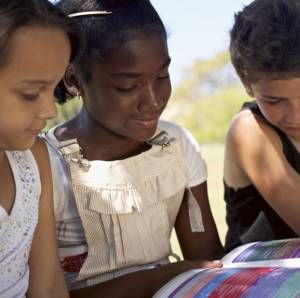
Boy Books, Girl Books, and Missing Out on Anne Frank
This is a guest post from Alison Doherty. Alison lives in Brooklyn and recently graduated from The New School with an MFA in writing for children. She blogs about young adult books at Hardcovers and Heroines and is working on her first novel. Follow her on Twitter @alisoncdoherty.
I went to what can only be described as a super progressive middle and high school. The walls were covered in student murals. In a poll on the 2000 presidential candidates there was basically a tie between Gore and Nader. We had a reputation around town for not wearing shoes. When we did wear shoes more often than not they were Birkenstocks.
In the classroom, we talked about gender equality, sexuality, and sexual orientation basically from the time I started in the 5th grade and onwards. But even in my super progressive school…
…we read a lot of boy books.
The idea of boy books and girl books can be controversial. Books can’t have a sex. They don’t have genitals. They can’t have a gender. How would they express it? They are rectangles made of glued together paper or files downloaded onto an e-reader. More and more I see authors declare that we need to move beyond the idea of saying girls can read boy books and boys can read girl books and just say that books are books. Anyone who can read can read them.
I have a problem with this well-intentioned line of thought.
In theory, I love it. But in practice, it can shift the binary of boy books versus girl books to one that is books for everyone versus books for girls. Too often boys don’t read anything relating to female experiences. And there are enormous adult misconceptions and pressures to keep it this way.
Fairytale goddess Shannon Hale wrote about this last year. And last week, author Caroline Paul wrote about her own experience promoting her book The Gutsy Girl: Escapades for Your Life of Epic Adventure in a blog post titled Why Boys Should Read Girl Books. Both write about the problem with more eloquence and experience than I have. But in sifting through these discussions a memory from my 7th grade English class won’t leave me alone.
As I said, in middle school we read a lot of books about boys (many of them about white boys and their dogs, a trope lamented by 11-year-old Marley Dias earlier this year). My Brother Sam Is Dead. Where the Red Fern Grows. Johnny Tremain. Rifles for Watie. Shiloh. I could keep going.
In a unit on the Holocaust, we prepared to read the play version of The Diary of Anne Frank, adapted by Albert Hackett and Frances Goodrich. It’s a good play. There are many good reasons to study it. Still, I don’t remember the names of the dogs in Where the Red Fern Grows or the color of Johnny Tremain’s pantaloons. But over a decade later, I remember our teacher explaining why we were reading the play instead of the original source.
Our teacher said reading about Anne Frank’s feelings in the diary made boys in past classes feel uncomfortable. The play provided distance from the interiority revealed in the diary. This made the play more appropriate.
I was upset and read the diary on my own, probably trying to find the juicy internal thoughts that made boys feel so uncomfortable. Of course I came up short. Anne Frank doesn’t describe anything particularly titillating or scandalous. She has thoughts and feelings and crushes and parent problems. She thinks about her body. She worries about her future, which, as we all know, was tragically cut short. Anne is a person. That it was more acceptable to discuss a character than an actual human being sent a strong (and I’m sure unintended) message to the boys in our class: it’s okay to ignore the experiences of women, especially if they make you uncomfortable.
I wonder why the message couldn’t have been that it is okay, encouraged even, to feel uncomfortable. Learning about people who are other is rarely easy. Confronting privilege is even harder. But both are incredibly valuable. The Diary of Anne Frank was not just a missed learning opportunity for my 7th grade class, it was a moment in which the wrong lesson was taught.
As a girl who also had thoughts and feelings and crushes and parent problems. A girl who thought about her body. Who thought about her future. The wrong lesson was passed on to me as well. If the boys in my class were uncomfortable with Anne, they would certainly be made uncomfortable if I told the truth about my experiences.
I didn’t have the language to articulate why this decision made me feel so uncomfortable at the time. But I do think it was clear, even at thirteen years old, that my discomfort wasn’t going to be the one that dictated the curriculum.
Today, fifteen years later, many more extreme versions of this story still fill classrooms. This hurts boys. It hurts girls. It hurts children who don’t define themselves by either gender. It needs to stop.







